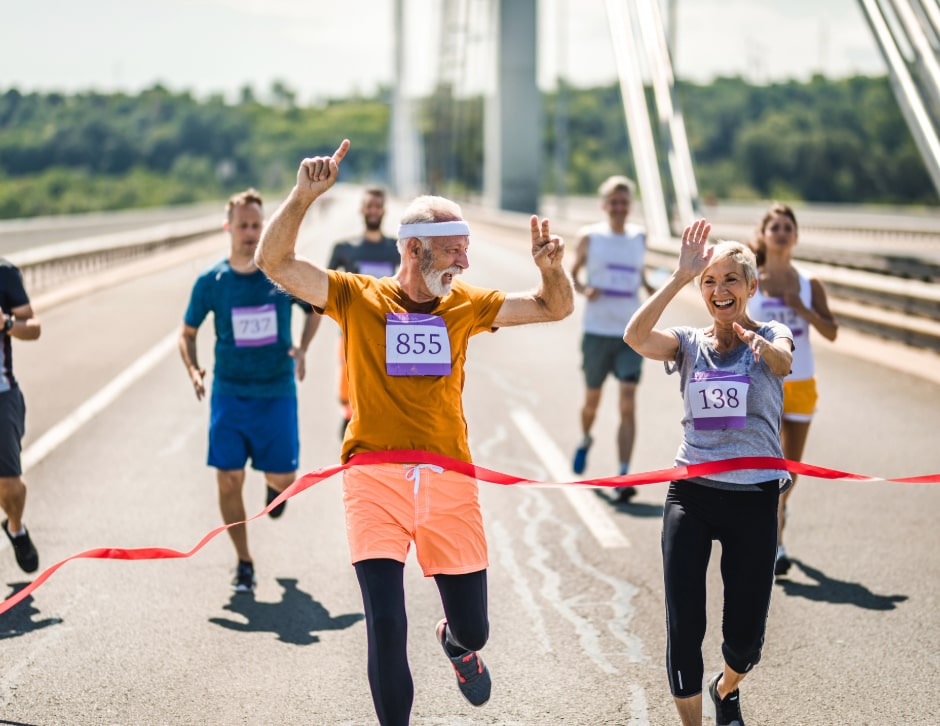
Here’s what we’ll cover in this blog post:
- Why older Olympians can still perform
- How health technology is changing sports
- What Olympians are using to optimize their health
- How we can push our health past our age limits
Have you noticed that Olympians are older than average this year?
From Lebron James leading the US Men’s National Basketball team at age 39, to Nino Salukvadze setting the women’s record for most Olympic appearances at age 55, to Simone Biles clutching gold as the oldest US gymnast ever, age seems to no longer be a hurdle for the world’s most anticipated athletic event.
But how are “older” athletes suddenly competing on the national stage more than ever before? What’s changed?
A Performance of Ages
The Washington Post described this year’s Olympics as a “celebration of age equality,” and they weren’t the only savvy viewers who noticed the average age of Olympians seems to be at its peak.
The 2024 Summer Olympics marks Lebron James’ fourth appearance for the US Men’s National Basketball team, and his second stint as captain after taking a 12-year hiatus. This will also make Lebron the oldest player ever to play for the US team at age 39. Lebron took the throne as captain of the team after Kobe Bryant stepped down in 2012, when he was 33.
Nino Salukvadze, the Georgian sport shooter, also became a ten-time Olympian this year at age 55. She sets the record for most appearances by a woman and ties the record for most appearances by any athlete. Yusuf Dikeç—a Turkish sport shooter who became an overnight sensation after photos of his gearless look went viral—also became Turkey’s oldest ever Olympic medalist after winning his first Olympic medal at age 51.
Even Simone Biles makes history at this year’s Olympics by becoming the oldest American gymnast to win a gold medal at just 27. This might still seem young to some, but keep in mind that the average age of the US Women’s Olympic Gymnastics team is only 22.5, while the average age of gymnastic medal winners in the 2020-1 Olympics was 20 (which was still the highest average in 50 years!).
But the list of age-bending athletes at this year’s Olympics doesn’t stop there. Diana Taurasi leads the US Women’s National Basketball team at age 42, less than a year shy of the oldest ever US Olympic basketball player, Lauren Jackson. Rafeal Nadal will also make his fourth appearance for Spain at age 38, while Novak Djokevic recently clutched his first gold medal at age 37.
The Olympian Secret
So, what’s behind the age-defying performances at this year’s Olympics? Kara Winger, a US Olympic javelin thrower, suggested that technology is a large factor in an interview with Scientific American. Winger, a four-time Olympian, is 38.
“I think there are so many tools these days that can tell athletes about their bodies and their recovery process,” Winger explains. “Many, many athletes now wear something that tells them how they’re recovering, how they’re sleeping, how their body is feeling….”
Beyond the top-notch sports science technology and testing that only leading athletes can access, Scientific American points out that tracking diet, sleep, progress, and other metrics are impacting the training world significantly.
In the same interview, US Olympic triathlon coach Ryan Boltonexplains that his Olympic athletes use the same basic technology most people use for their casual workouts at home: “just a smartwatch or a computer that they put on their bikes.”
That means some of the most valuable tools for Olympians are actually quite accessible to even non-Olympians.
How to Optimize Like an Olympian
It’s no secret that tracking how your habits and lifestyle affect your health can give you valuable insights that can keep you performing longer. The difference is we can use these same insights to help us live healthier for longer, as well.
If you have an Apple Watch, you have access to many of the same tools that top Olympic athletes rely on. Tracking your healthy sleep patterns, blood oxygen, heart rate, and respiratory rate not only allow you to optimize your fitness routine, but set you up for success in your longevity journey.
You may have seen Olympic swimmers wearing little white buttons attached to the back of their arms. These devices are called Continuous Glucose Monitors, which Olympians use to optimize their caloric intake and workout intensity. CGMs like the FreeStyle Libre track your glucose levels over a 14-day period, providing actionable insights on how your diet, exercise, or medications affect your glucose levels. Glucose is vital to maintain both our energy levels and metabolism, to maintain your quality of life as you age while also avoiding several age-related disease.
Olympians also rely on heart health biomarkers like HbA1C, triglycerides, and total cholesterol to ensure their metabolism is ready for competition. Getting access to the same biomarkers is incredibly easy, with a simple blood test that measures 11 key biomarkers most likely to impact your health. These quick blood tests can even assess diabetes and inflammation biomarkers so you can take control of your health.
You can’t optimize what you don’t measure, and many older Olympians seem to be taking this to heart. By prioritizing health and performance biomarkers and using data to guide your diet, exercise, and other lifestyle habits, you can take control of your health and take steps to maintain your health into old age, just like an Olympian.
Note: The above statements have not been evaluated by the Food and Drug Administration. This product is not intended to diagnose, treat, cure, or prevent any disease.
